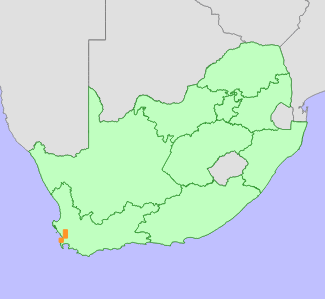|
Scientific Name | Disa barbata (L.f.) Sw. |
Higher Classification | Monocotyledons |
Family | ORCHIDACEAE |
Synonyms | Herschelia barbata (L.f.) Bolus, Herschelianthe barbata (L.f.) N.C.Anthony, Orchis barbata L.f., Satyrium barbatum (L.f.) Thunb. |
National Status |
Status and Criteria | Critically Endangered C2a(ii) |
Assessment Date | 2012/08/31 |
Assessor(s) | L. von Staden, B. Bytebier, W.R. Liltved, E.G.H. Oliver & T.A. Oliver |
Justification | This species used to occur on the Cape Flats and the Cape Peninsula, but is now locally extinct in these areas due to habitat loss to urban development. It is now reduced to a single surviving subpopulation in the Malmesbury area. Annual monitoring between 2001 and 2006 indicated that there are ± 110 mature individuals remaining. Continuing decline is occurring due to invasion by alien acacias, and loss of pollinators as a result of incorrect fire management. |
Distribution |
Endemism | South African endemic |
Provincial distribution | Western Cape |
Range | Malmesbury. Extinct on the Cape Flats. |
Habitat and Ecology |
Major system | Terrestrial |
Major habitats | Cape Flats Sand Fynbos, Atlantis Sand Fynbos |
Description | Marshy areas on acid sand flats below 200 m. |
Threats |
| Disa barbata was formerly a very common species on the Cape Flats around Cape Town (Liltved and Johnson, unpubl.) Urban expansion probably caused a population reduction of more than 90%. The last record of this species from the Cape Flats dates from 1950, indicating that the population reduction probably occurred more than three generations ago.
Currently one small population survives along the fence line of a small nature reserve near Malmesbury. This nature reserve was formerly densely covered by alien invasive acacias, but these have been largely cleared and re-invasions are being managed. The area outside the reserve fence, where about half the population occurs, is however severely degraded and densely covered in alien invasive plants.
Bytebier (2004) has noted that pollination success in the D. barbata population is generally low. The species is pollinated by a specialist carpenter bee, which requires dead wood for nesting sites. Fires provide nesting sites in the fynbos ecosystem, and management in terms of a suitable fire regime is required in the reserve. |
Population |
The population consists of two clumps, one of about 60 plants inside the reserve, and another of about 50 plants outside the reserve fence. Separated by only a few hundred meters, they are close enough to be considered a single subpopulation. Plants outside the reserve are suspected to be declining due to competition from alien invasive acacias and inappropriate fire management.
|
Population trend | Decreasing |
Notes |
| Flowering is not fire dependent. |
Assessment History |
Taxon assessed |
Status and Criteria |
Citation/Red List version | | Disa barbata (L.f.) Sw. | CR C2a(ii) | Raimondo et al. (2009) | | Disa barbata (L.f.) Sw. | VU D2 | Victor (2002) | | Herschelianthe barbata (L.f.) N.C.Anthony | Endangered | Hilton-Taylor (1996) | | Herschelia barbata (L.f.) Bolus | Endangered | Hall et al. (1980) | |
Bibliography |
Bytebier, B. 2004. Disa barbata. PlantTalk 35:32-33.
Hall, A.V., De Winter, M., De Winter, B. and Van Oosterhout, S.A.M. 1980. Threatened plants of southern Africa. South African National Scienctific Programmes Report 45. CSIR, Pretoria.
Hilton-Taylor, C. 1996. Red data list of southern African plants. Strelitzia 4. South African National Botanical Institute, Pretoria.
Liltved, W.R. and Johnson, S.D. Unpublished. The Cape Orchids - Wild orchids of the Cape Floral Kingdom.
Linder, H.P. 1981. Taxonomic studies in the Disinae. VI. A revision of the genus Herschelia. Bothalia 13(3 & 4):365 - 388.
Linder, H.P. and Kurzweil, H. 1999. Orchids of southern Africa. A.A. Balkema, Rotterdam.
Raimondo, D., von Staden, L., Foden, W., Victor, J.E., Helme, N.A., Turner, R.C., Kamundi, D.A. and Manyama, P.A. 2009. Red List of South African Plants. Strelitzia 25. South African National Biodiversity Institute, Pretoria.
Victor, J.E. 2002. South Africa. In: J.S. Golding (ed), Southern African plant Red Data Lists. Southern African Botanical Diversity Network Report 14 (pp. 93-120), SABONET, Pretoria.
|
Citation |
| von Staden, L., Bytebier, B., Liltved, W.R., Oliver, E.G.H. & Oliver, T.A. 2012. Disa barbata (L.f.) Sw. National Assessment: Red List of South African Plants version 2024.1. Accessed on 2025/10/30 |
 Comment on this assessment
Comment on this assessment


